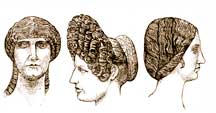The
Household
Romans
sought to expand their family by marriage, divorce, adoption, and
re-marriage. Ex-in-laws were important and children weren't lost through
divorce. Bonds of love between the generations were strong. Romans
needed large families obligated to support their political ambitions.
Fertile wives were divorced and remarried to form alliances for political
expedience -- sometimes while pregnant. Clients also augmented the
support network. The patron, patronus, from which comes the Italian
padrino, godfather, protected his clients if they got in trouble with
the law, but expected their full, visible support on public occasions
and loyalty on others. In addition to wives and children, the family
unit, familia, included household slaves. It wasn't just grandma and
grandpa living upstairs, but great-grandfather ruling the roost, along
with the subordinate uncles, first and second cousins. This may have
been more the ideal than the practice, but as long as that pater familias
was alive, no Roman could do business in his own name unless the progenitor
had emancipated him.
Shops
Roman
shops were mostly booths opening directly on to the street.  Right:
a cutler at his workshop. One man holds an iron bar and works the
bellows for the fire at the back, while another hammers on an anvil.
Various tools, including pincers, hang above. Below: a butcher at
work on a pig's head. Behind him hang another pig's head, a ham, pigs'
udders, a side of bacon and a lung. And someone with small respect
for the dead has carved, ungrammatically, "To Marcius always drunk."
Right:
a cutler at his workshop. One man holds an iron bar and works the
bellows for the fire at the back, while another hammers on an anvil.
Various tools, including pincers, hang above. Below: a butcher at
work on a pig's head. Behind him hang another pig's head, a ham, pigs'
udders, a side of bacon and a lung. And someone with small respect
for the dead has carved, ungrammatically, "To Marcius always drunk."

More
small watercourses than are in use today served to transport merchandise
in the Roman Empire. In the relief below a small barge carrying two
barrels of wine is being pulled along a stream in Gaul. Two men [one
not shown] tug at the ropes (there must have been three originally)
and another steers with an oar. Like sailors, they sang shanties to
keep the rhythm and lighten their task.

Bread
was still in the oven of Modestus, baker of Pompeii, when it was excavated
after nearly 2000 years.

Home
and Beauty
To
the Romans the family was a strong unit. The charming relief (left)
shows a family meal, the wife sitting in a chair (as the custom was),
her youngest child on her knee, and t he
husband reclining. The older children stand nearby. Below: the cult
of beauty. A wealthy lady is seated in a round-backed wicker chair
with her feet on a footstool. She is not in a beauty-parlour, for
none existed, but at home. Her four neat slave-girls are busy around
her: one holds a perfume flask, a second poses a mirror, a third waits
with a small pitcher, and arranging her hair is the ornatrix-- an
important member of the slave household who also saw to the rouge,
lipstick and eye-shadow.
he
husband reclining. The older children stand nearby. Below: the cult
of beauty. A wealthy lady is seated in a round-backed wicker chair
with her feet on a footstool. She is not in a beauty-parlour, for
none existed, but at home. Her four neat slave-girls are busy around
her: one holds a perfume flask, a second poses a mirror, a third waits
with a small pitcher, and arranging her hair is the ornatrix-- an
important member of the slave household who also saw to the rouge,
lipstick and eye-shadow.

Three
hair styles from imperial Rome — mid first century AD, later  first
century AD, and 2nd century. Fashions changed so quickly that one
sculptor made a portrait head with detachable scalp, so that he could
keep the hairstyle always up to date.
first
century AD, and 2nd century. Fashions changed so quickly that one
sculptor made a portrait head with detachable scalp, so that he could
keep the hairstyle always up to date.
Pictures
and text (Shops and Home and Beauty) are from
"The Birth of Western Civilization" ed. Michael Grant
